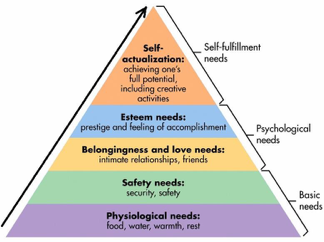Lesson 1: A Holistic Approach
Attention

Maslow's Hierarchy of Needs
Google
Learning Outcomes
Upon completion of this lesson's material, students will be able
- Demonstrate understanding of how family and cultural beliefs influence health, safety and nutrition attitudes and practices
- Discuss the role of the teacher in providing a safe and healthy environment
- Demonstrate knowledge of the impact of environmental influences on early brain development
Teaching
Read Chpt 1 Safety, Nutrtion &Health
Needs
Children and adults need to feel safe and secure in order to learn, develop and grow. Safety is both physical and emotional.
Psychologist Abraham Maslow (https://en.wikipedia.org/wiki/Abraham_Maslow) developed a theory referred to as “Maslow’s Hierarchy”. (https://en.wikipedia.org/wiki/Maslow%27s_hierarchy_of_needs) This theory discusses the importance of safe, nurturing environments, including health and nutrition.
There are numerous factors that contribute to a child’s health and well-being. This begins with environmental factors that influence brain development. (https://youtu.be/MS5HUDVNbGs) Babies who are exposed to chronic stress, poor nutrition, drug/alcohol abuse, etc in utero and/or during early development after birth, have brains that are wired differently that babies who have healthy support systems. This can lead to trouble learning and developing for their entire lifetime.
Family culture and beliefs about health, safety and nutrition also impact the child. It is the caregiver’s role to respect the values of the families within the program while providing a safe and nurturing environment.
Teachers are responsible for creating a safe physical and emotional environment for the children to grow and learn in. There are regulations that address some specific requirements. In the state of Maine, child care centers, preschools and family providers are required to follow the Maine
Child Care Licensing Laws
www.maine.gov/sos/cec/rules/10/148/148c032.doc
A Child Care licensing specialist will do site visits to ensure that each program is following these safety guidelines. If a program is found to be in violation of these rules there is a process to rectify the situation. However, if there is a danger to the children or the provider does not correct issues, the center can lose their license and will have to close.
Children who have teachers and families who work together to provide a supportive environment are more likely to be successful. Confidentiality needs to be maintained at all times. Caregivers should never discuss personal information about the children in their care with anyone other than therapists or medical personnel that families have given permission to share information with.
The National Association for the Education of Young Children (NAEYC)
Provides a Code of Ethical Conduct that outlines proper behavior and relationships for working with families. NAEYC says that parents and teachers need to work together, caregivers need to respect family cultural beliefs and confidentiality. Please review this document for more details.
Assessment
Lesson 1 Quiz
Lesson Quizzes will consist of material from the lesson, the discussions, and from assigned reading. Questions will be True/False, Multiple Choice, and Short Answer. Be sure to review all the Lesson and Reading material prior to starting this quiz.
Lesson 1 Discussion
What are 3 specific ways you could prepare your curriculum and/or environment to address the 6 goals for creating quality environments for children? List the corresponding goal(s) you are targeting.
For full credit in the graded discussions you need to post at least ONE response to the prompt in the Lesson and reply to at leaset TWO other students' posts. Your reply posts must be substantive. Please see the grading rubric in the Syllabus for this course for more details.
These instrucitons apply to all the graded discussions in this course and will not be repeated.